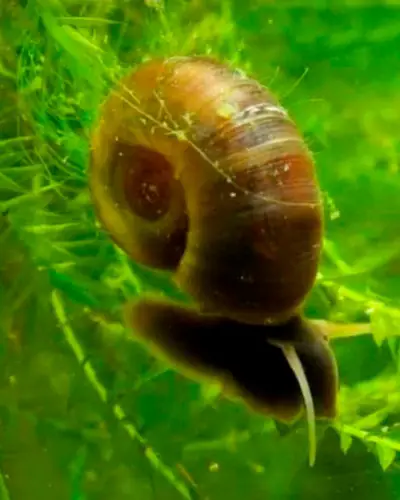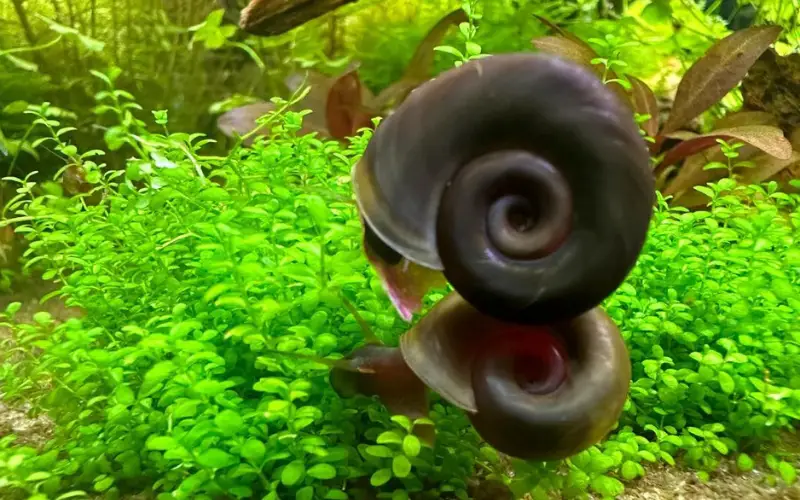How fast do ramshorn snails reproduce? One key factor that makes ramshorn snails popular for aquarium enthusiasts is their ability to produce quickly. These freshwater snails are known for their prolific breeding habits, often leading to a population explosion if not kept in check.
Ramshorn snails are hermaphroditic, meaning they possess both male and female reproductive organs, allowing them to reproduce at a rapid pace.
In ideal conditions, a single ramshorn snail can lay dozens of eggs at a time, which hatch in just a few weeks later.

This rapid reproductive rate can be a double-edged sword for aquarium owners. While it can help keep a tank clean by consuming algae and decaying plant matter, it can also lead to overpopulation if not correctly managed.
Understanding ramshorn snail care and breeding habits is essential for maintaining a healthy and balanced aquatic environment.
Table of Contents
ToggleHow Long Does It Take for Ramshorn Snails to Breed?
Ramshorn snails are mostly found in ponds and aquariums. These snails in freshwater come in various colors, including pink and blue.
They can multiply really fast, especially in tropical tanks. Ramshorns lay their eggs in clusters on surfaces like live plants and tank substrates.
It takes about 12 days for the snail eggs to hatch. Assassin snails are often used to control pest snails like ramshorns.
Despite being small, ramshorn snails are larger snails that may need a lid on the tank to prevent them from escaping. Some fertilize lettuce or feed on algae.

If you have a pest snail problem, quarantine is essential before introducing new ramshorn snail tank mates like shrimp, goldfish, or cichlids.
Ramshorn snails start laying eggs when they reach maturity. They can be moved from one tank to another, so keeping an eye on their population is essential.
Calcium and proper pH levels are crucial for their clutch to develop well. Larger snails may end up eating the eggs, so it’s necessary to separate them if needed.
Ramshorn snails float to the surface of the water to get air, which is an expected behavior among aquarium snails. They come in different sizes, and some managed to eliminate parasites in fish tanks.
How Fast Do Ramshorn Snails Reproduce in Fish Tank?
Ramshorn snails are a hardy and unusually fertile snail species that can reproduce rapidly in a fish tank. These pond snails come in different colors and can be produced quickly under the right conditions.
A single gallon tank can quickly become overrun with these snails if not kept in check by the aquarist. Each clutch of ramshorn snail eggs can take around 12 days to hatch; before you know it, you’ll have a population explosion.
These snails need enough plant leaves or moss to seal themselves in until they are ready to hatch. Once they hatch, the newborn snails will thrive in their habitat.
Some fish like to eat these snails, so having a few in your tank could be a fluke of nature. You may find your tank overrun with Ramshorn snails and need help figuring out what to do. To prevent this, keep your red ramshorn snail tank clean and do regular water changes to help control their population.
If you do end up with too many, you may need to manually remove them or introduce a predator, such as betta fish, which will help keep their numbers in check. Remember, these snails can reproduce quickly, so staying on top of their population is essential before it spirals out of control.
Understanding Ramshorn Snails Reproduction
Here’s a breakdown of the Ramshorn snail reproduction cycle:
1. Mating:
- Two snails encounter each other. Since they’re hermaphrodites, any pairing can result in reproduction.
- They may wrestle or position themselves to fertilize each other’s eggs mutually.
2. Egg Laying:
- A snail lays a clutch of eggs. These are clear, jelly-like globs containing about a dozen eggs, although the number can fluctuate.
- Eggs are attached to hard surfaces like plants, decorations, or aquarium glass.
3. Egg Development:
- The eggs are translucent, allowing the baby snails to develop inside.
- Over a few days, the eggs become less clear as the baby snails grow.
- Hatching usually occurs within 10-20 days, depending on water temperature.
4. Newborn Snails:
- Baby ramshorn snails are tiny and have clearish-white shells.
- They can immediately feed on algae, residue, and leftover food in the aquarium.
5. Maturity and Reproduction:
- The baby snails grow rapidly.
- They reach sexual maturity within a few weeks.
- The newly mature snails begin mating and laying eggs, continuing the cycle anew.
Key Points
- The entire reproductive cycle can be completed in as little as a month, contributing to their potential to become a tank nuisance.
- Ramshorn snails can sometimes self-fertilize, but they prefer to cross-fertilize where possible.
How Long Does It Take For A Ramshorn Snail To Be Sexually Mature?
Ramshorn snails become sexually mature surprisingly quickly! They reach sexual maturity in about 4-6 weeks. This means they can start laying eggs very early in their lifespan.
- Identifying a mature ramshorn snail: You can’t quickly tell if they’re sexually mature by looking at them, as snails don’t change appearance much at that point.
Here’s why their rapid reproduction is essential to consider:
- Snail populations can explode: A single ramshorn snail can lay hundreds of eggs in its lifetime. If conditions are good, a tank can quickly become overpopulated with snails.
- Benefits of ramshorn snails: Despite being seen as pests by some, ramshorn snails can be beneficial tank cleaners. They eat algae and leftover food, keeping the tank tidy.
The Lifespan of Ramshorn Snails
The lifespan of Ramshorn Snails can vary depending on their environment and care. These small gastropods are known for their ability to reproduce quickly and in large numbers. A Ramshorn Snail will typically live for 1 to 2 years in a well-maintained heated aquarium.
They can produce every clutch of eggs in a gel-like coating attached to surfaces such as plants and rocks. These eggs will hatch, and the baby snails will emerge, ready to search for food in the bottom world of the tank.
Providing a consistent source of and a balanced diet will help ensure the snails reach their entire potential lifespan.
Commonly Asked Questions about How Fast Do Ramshorn Snails Reproduce in Aquarium (FAQs)
Why are there baby snails in my fish tank?
Baby snails appear in fish tanks because adult snails or their eggs are hitchhiked on live plants, decorations, or from another tank.
How often do freshwater snails lay eggs?
The frequency of egg-laying in freshwater snails varies significantly between species. Some, like Mystery Snails and Ramshorn Snails, lay eggs every few weeks, while others, like Ramshorn Snails, may lay eggs only a few times a year. Water parameters, temperature, and food availability influence egg production.
Can one ramshorn snail reproduce?
Yes! Rams horn snails are hermaphrodites, meaning they have both male and female reproductive organs, allowing a single snail to reproduce.
Could a snail have laid eggs on another snails shell?
No, snails cannot lay eggs directly on another snail’s shell. They lay their eggs in moist soil, on plants, or in other sheltered locations. While they might crawl on another snail’s shell, it wouldn’t be suitable for egg development.
What is a full size Ramshorn snail?
A full-size Ramshorn snail boasts a shell reaching around 1 inch (2.5 cm) in diameter, roughly the size of a large dime. Their shells can be translucent or shades of brown, even nearly black.
What do aquatic snails do?
Aquatic snails act as nature’s aquarium cleaners, munching on algae, leftover food, and decaying plant matter, keeping your tank sparkling!
How many babies do Ramshorn snails have?
Ramshorns lay clusters of about a dozen eggs, sometimes more! You won’t see babies crawling around, Lol, but plenty of tiny snails will appear soon after the eggs hatch.
How do you breed Ramshorn snails fast?
While it’s possible to encourage Ramshorn snail breeding by providing ample food like blanched veggies and maintaining ramshorn snails’ good water quality, rapidly breeding them isn’t recommended. Their fast reproduction can easily overwhelm an aquarium, leading to overpopulation and potential ecosystem imbalances. Consider alternative methods for managing snail populations if necessary.
What is the fastest reproducing snail?
Several snail species reproduce quickly, but bladder snails, ram horn snails, and Malaysian trumpet snails are often considered the fastest-reproducing snails in aquariums.
Conclusion
So, how fast do ramshorn snails reproduce? Ramshorn snails are known for their rapid breeding rate, making them popular in freshwater aquariums. These snails can reproduce asexually, laying eggs that hatch into miniature versions of themselves. A single snail can produce a large population in a relatively short time.
However, the speed at which ramshorn snails reproduce can be both a blessing and a curse for aquarium enthusiasts. On the one hand, they can quickly populate a tank and help clean up algae and debris. On the other hand, if left unchecked, they can overrun a small tank and become a nuisance.
It is essential for aquarium owners to carefully monitor the population of ramshorns in their tanks and take preventative measures to control their numbers. This can include adjusting the temperature of the water, as these snails tend to reproduce more rapidly in warm environments.
In val areas, ramshorn snails may be beneficial in maintaining a balanced ecosystem, but they can become a problem in excess. By understanding the reproduction habits of these snails and taking proactive measures, aquarium enthusiasts can enjoy the benefits of these transparent creatures without the upside of overpopulation.
You might also like
- Are Ramshorn Snails Invasive: (Shocking Truth Revealed!)
- Ramshorn Snail Temperature 101: (A Detailed Care Guide)
- Identifying Baby Ramshorn Snail in Your Tank (Proven Tips!)
- How Long Do Snail Eggs Take to Hatch: A Comprehensive Guide
- How Often Do Ramshorn Snails Lay Eggs in Aquarium: Explained
- How Many Ramshorn Snails Per Gallon Tank: (Aquarium Advice)
- Eliminating Pest Snails Aquarium the Easy Way (Solved)




